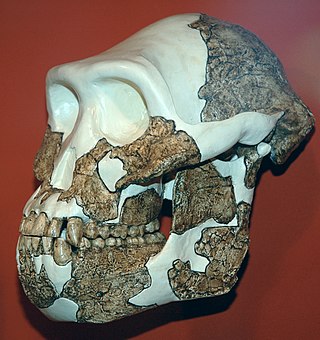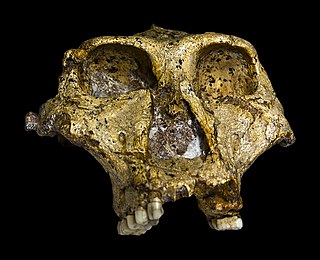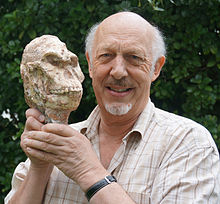
Australopithecus (, OS-trə-lə-PITH-i-kəs, -loh-; or is a genus of early hominins that existed in Africa during the Pliocene and Early Pleistocene. The genera Homo, Paranthropus, and Kenyanthropus evolved from some Australopithecus species. Australopithecus is a member of the subtribe Australopithecina, which sometimes also includes Ardipithecus, though the term "australopithecine" is sometimes used to refer only to members of Australopithecus. Species include A. garhi, A. africanus, A. sediba, A. afarensis, A. anamensis, A. bahrelghazali and A. deyiremeda. Debate exists as to whether some Australopithecus species should be reclassified into new genera, or if Paranthropus and Kenyanthropus are synonymous with Australopithecus, in part because of the taxonomic inconsistency.

Meganthropus is an extinct genus of non-hominin hominid ape, known from the Pleistocene of Indonesia. It is known from a series of large jaw and skull fragments found at the Sangiran site near Surakarta in Central Java, Indonesia, alongside several isolated teeth. The genus has a long and convoluted taxonomic history. The original fossils were ascribed to a new species, Meganthropus palaeojavanicus, and for a long time was considered invalid, with the genus name being used as an informal name for the fossils.
Paleoanthropology or paleo-anthropology is a branch of paleontology and anthropology which seeks to understand the early development of anatomically modern humans, a process known as hominization, through the reconstruction of evolutionary kinship lines within the family Hominidae, working from biological evidence and cultural evidence.

The Cradle of Humankind is a paleoanthropological site that is located about 50 km (31 mi) northwest of Johannesburg, South Africa, in the Gauteng province. Declared a World Heritage Site by UNESCO in 1999, the site is home to the largest known concentration of human ancestral remains anywhere in the world. The site currently occupies 47,000 hectares (180 sq mi) and contains a complex system of limestone caves. The registered name of the site in the list of World Heritage Sites is Fossil Hominid Sites of South Africa.

Sterkfontein is a set of limestone caves of special interest in paleoanthropology located in Gauteng province, about 40 kilometres (25 mi) northwest of Johannesburg, South Africa in the Muldersdrift area close to the town of Krugersdorp. The archaeological sites of Swartkrans and Kromdraai are in the same area. Sterkfontein is a South African National Heritage Site and was also declared a World Heritage Site in 2000. The area in which it is situated is known as the Cradle of Humankind. The Sterkfontein Caves are also home to numerous wild African species including Belonogaster petiolata, a wasp species of which there is a large nesting presence.

Mrs. Ples is the popular nickname for the most complete skull of an Australopithecus africanus ever found in South Africa. Many Australopithecus fossils have been found near Sterkfontein, about 40 kilometres (25 mi) northwest of Johannesburg, in a region of Gauteng now designated as the Cradle of Humankind World Heritage Site. Mrs. Ples was discovered by Robert Broom and John T. Robinson on April 18, 1947. Because of Broom's use of dynamite and pickaxe while excavating, Mrs. Ples's skull was blown into pieces and some fragments are missing. Nonetheless, Mrs./Mr. Ples is one of the most "perfect" pre-human skulls ever found. The skull is currently held at the Ditsong National Museum of Natural History in Pretoria.
Taung is a small town situated in the North West Province of South Africa. The name means place of the lion and was named after Tau, the Chief of the Legoya or Bataung people. Tau is the Tswana word for lion.

Australopithecus africanus is an extinct species of australopithecine which lived between about 3.3 and 2.1 million years ago in the Late Pliocene to Early Pleistocene of South Africa. The species has been recovered from Taung, Sterkfontein, Makapansgat, and Gladysvale. The first specimen, the Taung child, was described by anatomist Raymond Dart in 1924, and was the first early hominin found. However, its closer relations to humans than to other apes would not become widely accepted until the middle of the century because most had believed humans evolved outside of Africa. It is unclear how A. africanus relates to other hominins, being variously placed as ancestral to Homo and Paranthropus, to just Paranthropus, or to just P. robustus. The specimen "Little Foot" is the most completely preserved early hominin, with 90% of the skeleton intact, and the oldest South African australopith. However, it is controversially suggested that it and similar specimens be split off into "A. prometheus".

Homo rhodesiensis is the species name proposed by Arthur Smith Woodward (1921) to classify Kabwe 1, a Middle Stone Age fossil recovered from Broken Hill mine in Kabwe, Northern Rhodesia. In 2020, the skull was dated to 324,000 to 274,000 years ago. Other similar older specimens also exist.

Australopithecus anamensis is a hominin species that lived approximately between 4.3 and 3.8 million years ago and is the oldest known Australopithecus species, living during the Plio-Pleistocene era.

Liang Bua is a limestone cave on the island of Flores, Indonesia, slightly north of the town of Ruteng in Manggarai Regency, East Nusa Tenggara. The cave demonstrated archaeological and paleontological potential in the 1950s and 1960s as described by the Dutch missionary and archaeologist Theodor L. Verhoeven.

Paranthropus robustus is a species of robust australopithecine from the Early and possibly Middle Pleistocene of the Cradle of Humankind, South Africa, about 2.27 to 0.87 million years ago. It has been identified in Kromdraai, Swartkrans, Sterkfontein, Gondolin, Cooper's, and Drimolen Caves. Discovered in 1938, it was among the first early hominins described, and became the type species for the genus Paranthropus. However, it has been argued by some that Paranthropus is an invalid grouping and synonymous with Australopithecus, so the species is also often classified as Australopithecus robustus.

Paranthropus boisei is a species of australopithecine from the Early Pleistocene of East Africa about 2.5 to 1.15 million years ago. The holotype specimen, OH 5, was discovered by palaeoanthropologist Mary Leakey in 1959 at Olduvai Gorge, Tanzania and described by her husband Louis a month later. It was originally placed into its own genus as "Zinjanthropus boisei", but is now relegated to Paranthropus along with other robust australopithecines. However, it is also argued that Paranthropus is an invalid grouping and synonymous with Australopithecus, so the species is also often classified as Australopithecus boisei.

KNM ER 406 is an almost complete fossilized skull of the species Paranthropus boisei. It was discovered in Koobi Fora, Kenya by Richard Leakey and H. Mutua in 1969. This species is grouped with the Australopitecine genus, Paranthropus boisei because of the robusticity of the skull and the prominent characteristics. This species was found well preserved with a complete cranium but lacking dentition. He was known for his robust cranial features that showed the signs of adaptation of the ecological niches. The big chewing muscles attached to the sagittal crest are traits of this adaptation.

"Little Foot" is the nickname given to a nearly complete Australopithecus fossil skeleton found in 1994–1998 in the cave system of Sterkfontein, South Africa.

Selam (DIK-1/1) is the fossilized skull and other skeletal remains of a three-year-old Australopithecus afarensis female hominin, whose bones were first found in Dikika, Ethiopia in 2000 and recovered over the following years. Although she has often been nicknamed Lucy's baby, the specimen has been dated at 3.3 million years ago, approximately 100,000 years older than "Lucy".
Gladysvale Cave is a fossil-bearing breccia filled cave located about 13 kilometres (8.1 mi) northeast of the well-known South African hominid-bearing sites of Sterkfontein and Swartkrans and about 45 kilometres (28 mi) north-northwest of Johannesburg, South Africa. It is situated within the Cradle of Humankind World Heritage Site and is itself a South African National Heritage Site.

Malapa is a fossil-bearing cave located about 15 kilometres (9.3 mi) northeast of the well known South African hominid-bearing sites of Sterkfontein and Swartkrans and about 45 kilometres (28 mi) north-northwest of Johannesburg, South Africa. It is situated within the Cradle of Humankind World Heritage Site.
The Osteodontokeraticculture (ODK) is a hypothesis that was developed by Prof. Raymond Dart, which detailed the predatory habits of Australopith species in South Africa involving the manufacture and use of osseous implements. Dart envisaged Australopithecus africanus, known from Taung and Sterkfontein caves, and Australopithecus prometheus from Makapansgat, as carnivorous, cannibalistic predators who utilized bone and horn implements to hunt various animals, such as antelopes and primates, as well as other Australopiths.

SK 847 is the abbreviated designation for the fossilized fragments of a Homo habilis cranium, discovered in South Africa, which was dated to an age between 1.8 and 1.5 million years. This fossil shares morphological traits with the early African Homo erectus, sometimes known as Homo ergaster.
















